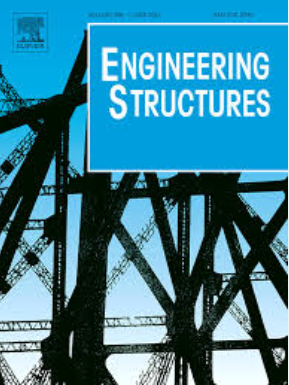一种用于提高自定心钢筋混凝土建筑框架抗震性能的新型干涉增强自定心阻尼器
IF 6.4
1区 工程技术
Q1 ENGINEERING, CIVIL
引用次数: 0
摘要
由于各种自定心装置的成功,可以减少甚至消除残余的层间漂移。然而,由于自定心框架独特的旗形滞回特性,其结构加速度响应可能会被放大,这可能会导致加速度敏感的非结构部件的严重损伤。因此,本文提出了一种新型的基于摩擦弹簧的自定心装置与阻尼器并联的自定心阻尼器(ISCD),通过对漂移和加速度响应的平衡控制,克服了上述缺点。阐述了所提出的ISCD的概念设计和理想力学模型。然后,设计了一栋6层的钢筋混凝土框架建筑,并安装了这些装置(如基于摩擦弹簧的自定心阻尼器、惯性器和拟议的ISCD)。通过非线性动力分析和增量动力分析对所提出的ISCD的有效性和优越性进行了评价。最后进行了地震恢复力评价,评价了ISCD对震后功能的影响。结果表明,ISCD在减小加速度响应的同时,对最大层间位移和剩余层间位移响应保持了良好的性能。此外,iscd通过减少高达20.46% %的地震损失和高达19.46% %的恢复时间,提供了结构安全和非结构保护之间的最佳平衡。本文章由计算机程序翻译,如有差异,请以英文原文为准。
A novel inerter-enhanced self-centering damper (ISCD) for improving seismic resilience of self-centering RC building frames
The residual inter-story drift can be reduced or even eliminated owing to the success of the various self-centering devices. Nevertheless, the structural acceleration response of the self-centering frames can be amplified due to their unique flag-shaped hysteretic behavior, which may cause severe damage of acceleration-sensitive nonstructural components. Hence, this paper proposes a novel inerter-enhanced self-centering damper (ISCD) that friction spring-based self-centering device and the inerter are arranged in parallel, to overcome the above shortcoming by providing balanced control on the drift and acceleration responses. The conceptual design and ideal mechanical model of the proposed ISCD are elaborated. Then, a 6-story reinforced concrete frame building is designed and equipped with the devices (e.g., the friction spring-based self-centering damper, the inerter, and the proposed ISCD). Nonlinear dynamic analysis and incremental dynamic analysis are conducted to evaluate the effectiveness and advantages of the proposed ISCD. Finally, seismic resilience assessment is conducted to assess the influence of the ISCD on the post-earthquake functionality. The results indicate that the ISCD demonstrates a satisfactory capacity for reducing acceleration response, while maintaining desirable performance on the maximum inter-story drift and residual inter-story drift responses. Furthermore, the ISCDs provide an optimal balance between structural safety and nonstructural protection by reducing up to 20.46 % of seismic loss and up to 19.46 % of recovery time.
求助全文
通过发布文献求助,成功后即可免费获取论文全文。
去求助
来源期刊

Engineering Structures
工程技术-工程:土木
CiteScore
10.20
自引率
14.50%
发文量
1385
审稿时长
67 days
期刊介绍:
Engineering Structures provides a forum for a broad blend of scientific and technical papers to reflect the evolving needs of the structural engineering and structural mechanics communities. Particularly welcome are contributions dealing with applications of structural engineering and mechanics principles in all areas of technology. The journal aspires to a broad and integrated coverage of the effects of dynamic loadings and of the modelling techniques whereby the structural response to these loadings may be computed.
The scope of Engineering Structures encompasses, but is not restricted to, the following areas: infrastructure engineering; earthquake engineering; structure-fluid-soil interaction; wind engineering; fire engineering; blast engineering; structural reliability/stability; life assessment/integrity; structural health monitoring; multi-hazard engineering; structural dynamics; optimization; expert systems; experimental modelling; performance-based design; multiscale analysis; value engineering.
Topics of interest include: tall buildings; innovative structures; environmentally responsive structures; bridges; stadiums; commercial and public buildings; transmission towers; television and telecommunication masts; foldable structures; cooling towers; plates and shells; suspension structures; protective structures; smart structures; nuclear reactors; dams; pressure vessels; pipelines; tunnels.
Engineering Structures also publishes review articles, short communications and discussions, book reviews, and a diary on international events related to any aspect of structural engineering.
 求助内容:
求助内容: 应助结果提醒方式:
应助结果提醒方式:


